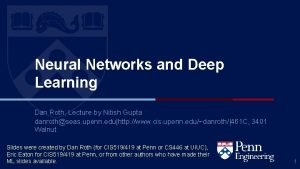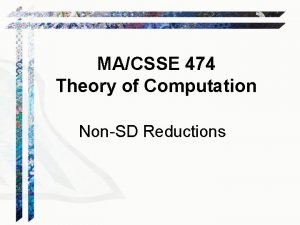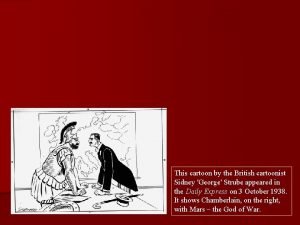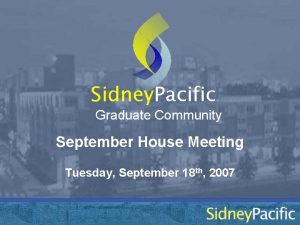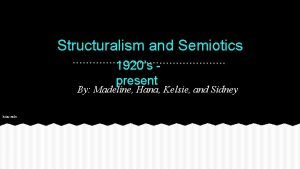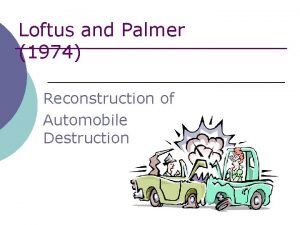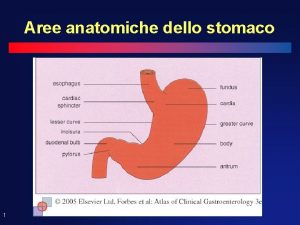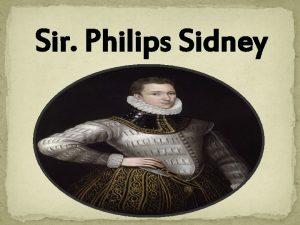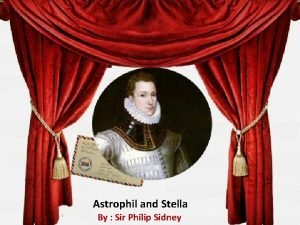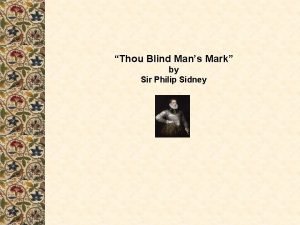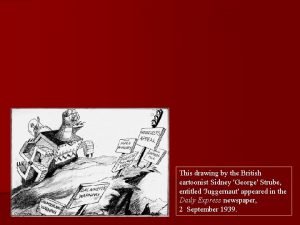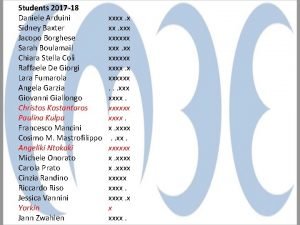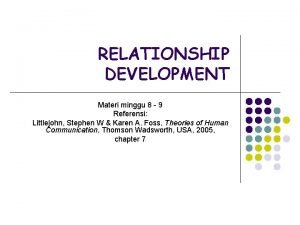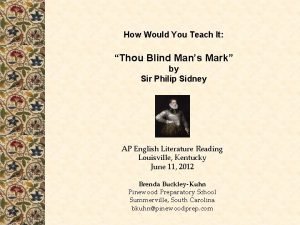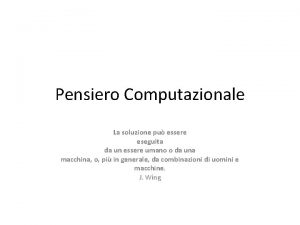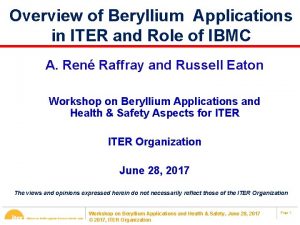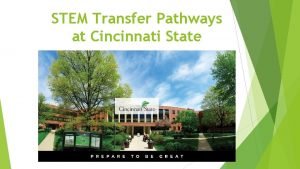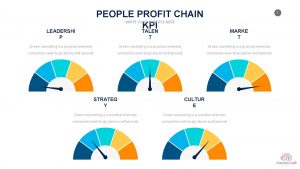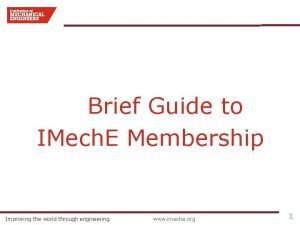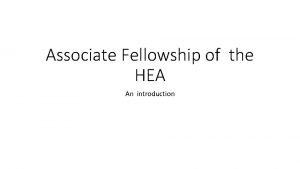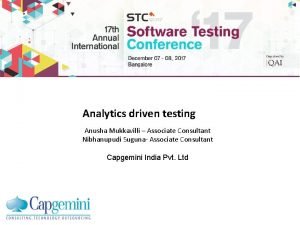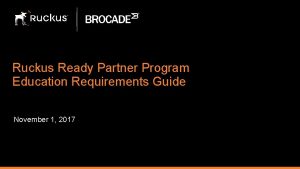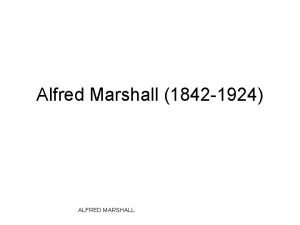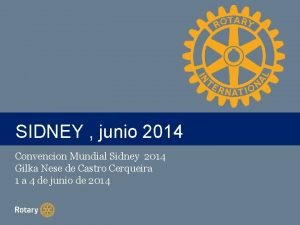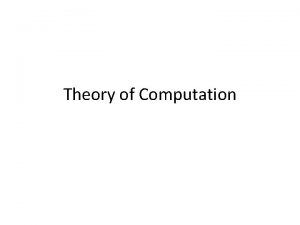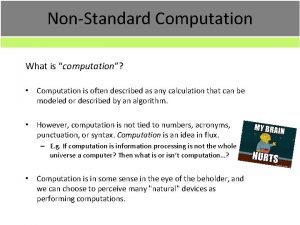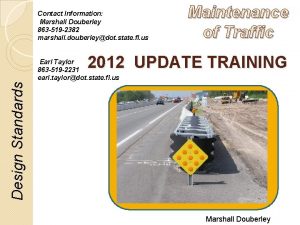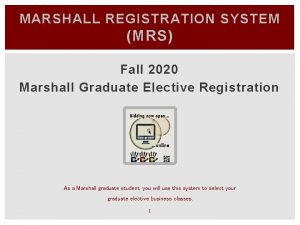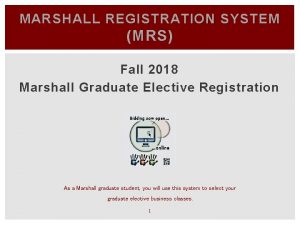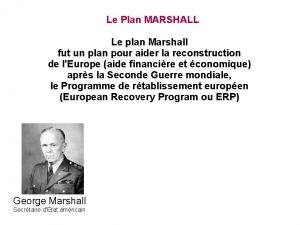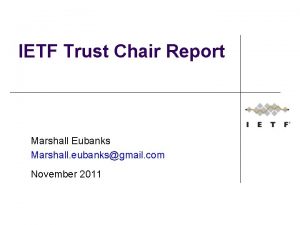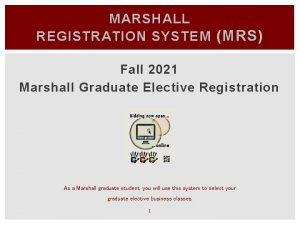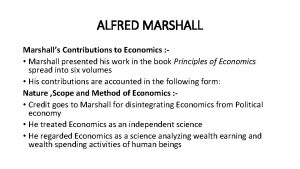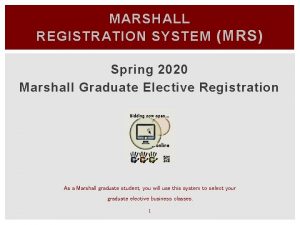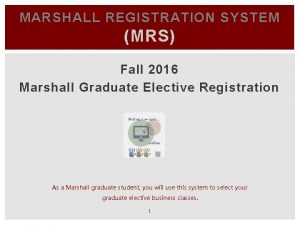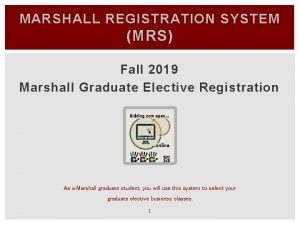The History of Computation Dr Sidney Marshall Associate































































- Slides: 63

The History of Computation Dr. Sidney Marshall Associate professor Rochester Institute of Technology

Why Do We Calculate? Ancient History • Ancient History – Measurement and Surveying - Nile River – Astronomy - Predicting Spring – Business Records

The Abacus • Originally stones on counting board • Chinese "swan pan" in China since 1300 A. D. • Imported as Japanese soroban • In 1946 the best abacus user beat the best electrically driven mechanical calculator in a contest

Chinese Swan Pan

Japanese Soroban

Russian Peasant Multiplication • Only requires doubling and halving – (duplation and mediation)

Multiplication - continued • How to do it – Write the two numbers at top – On successive rows halve the first number and double the second number – Stop when you get to 1 – Cross off every row with an even number in the first column – Add up the remaining numbers in the second column

Multiplication Example: • 21 27 • 10 54 • 5 108 • 2 216 • 1 432 • 567 = 21 x 27

Finger Reckoning • Educated people knew up to 5 x 5 • To multiply two numbers greater than 5: – Extend fingers for amount over 5 – Answer is sum of extended fingers followed by product of "closed" fingers • 7 x 8 = (2+3) and (3 times 2) = 5 6

Tally Sticks • Notched sticks used throughout history for record keeping • Used by English Government for accounts – Sticks were notched and split lengthwise into two pieces for each party – Accounts "tallied" by matching sticks

Tally Sticks Tally for £ 11 18 s 8 d from the reign of Henry III to the Reeve of Ledicumbe A tally for 6 s 8 d issued by the Treasurer of Edward I to the Sheriff of Lincolnshire

Tally Stick Fire of 1834 • The order went out that the tally sticks should be burned in a stove in the House of Lords. The stove, overgorged with these preposterous sticks, set fire to the panelling; the panelling set fire to the House of Commons; the two houses of government were reduced to ashes.

Fire caused by burning tally sticks

The Quadrant • A portable analog computer for trigonometrical and astronomical calculations – Calculations were performed using dividers to measure and transfer distances

The Sector • A hinged version of the quadrant • Used for artillery calculations • Calculations could be performed by measuring distances with a divider

Napier's Bones (1550 -1617) • Tiles containing a column of the multiplication table

Napier's invention of Logarithms 1614 • Method of prosthaphaeresis – sin a sin b = [cos(a-b) - cos(a+b)]/2 • Using Napier's Logarithms – log ab = log a + log b

Slide Rules • Based on logarithms • Could do multiplication, division, powers, roots, and trigonometric computations • Nearly 3 decimal digits of accuracy – All engineers used to have one

Slide Rule Operation • Adding lengths on a logarithm scale is equivalent to multiplying

Slide Rules

Slide Rules • More accuracy required a longer scale or more accurate mechanism • Many types of slide rules were invented – spiral, cylindrical, long steel tapes, magnifying devices

Cylindrical Slide Rule

Spiral Slide Rule

Graphical computing • planimeters • integrators

The Planimeter

Wilhelm Schickard (15921635) • First workable mechanical adding machine

Blaise Pascal (1623 -1662) • Several dials like telephone for entering numbers • 9's complement used for subtraction

Mathematical Tables - 1780's • Big effort to produce accurate tables – Powers and roots – Logarithms (addition/subtraction logarithms, quarter squares) – Trigonometric and Exponential tables for geometry • Most scientific calculations carried out with the help of tables

Jacquard's Loom (17521834) • Punched cards controlled weaving

Charles Babbage (17911871) • Designed many mechanical calculating machines – His "Difference Engine" was designed to calculate tables • Designed the "Analytical Engine" with many of the properties of our modern computers

Method of Differences 0. 7242758696 0. 0008186515 0. 7250945211 0. 0008171112 0. 7259116323 0. 0008155767 0. 7267272090 0. 0008140480 0. 7275412570 0. 0008125250 0. 7283537820 0. 0008110077 0. 7291647897 0. 0008094960 0. 7299742857 -0. 0000015403 0. 000058 -0. 0000015345 0. 000058 -0. 0000015287 0. 000057 -0. 0000015230 0. 000057 -0. 0000015173 0. 000057 -0. 0000015117

Babbage's Difference Engine

Babbage's Analytical Engine

Dorr Felt - Comptometer (1886) Designed (out of a macaroni box!) a reliable carrying mechanism

Mechanical Calculating Machines • The 1900's development of many calculators and cash registers – Some were hand powered and some were driven with an electrical motor • Calculators were the workhorse for scientific computation in the 1950’s – A “computer” was a person operating a mechanical calculator

Monroe calculator

Mechanical Differential Analyzers • Vannevar Bush developed the Differential Analyzer - 1930's – All mechanical machine for solving differential equations • Solved the equation dz = y dx – Electrical versions were made later • OP amps and analog computers • Digital differential analyzers

Bush Differential Analyzer

Card Punch equipment • 1880 census results available in 1888 • For the 1890 census Hollerith developed a punched card system • The 1900 census done 1 year 7 months after the results were in

Uses of "Tabulating" Cards • Business records • Subscription cards • Billing • Code Breaking • Atom Bomb Calculations

IBM Card

IBM Punched Card machines

Punch Card Control Panel

The telephone company • Largest distributed relay computer • Specification for telephone office was 1/2 hour outage in 40 years • George Stibitz built a relay computer in 1939 with telephone relays

The "modern" computer era • World War II – Code Breaking – Artillery firing tables – Atom Bomb Calculations

The ENIAC - 1944

The IBM 704 • First "modern" mass produced computer

Storage Technology • Mercury Delay Lines • Williams Storage Tube • Magnetic Core Memory • Semiconductor Memory – The Rule of 4

Core Memory

Off-line Storage • Punched Cards – Paper tape • Magnetic Tape • Magnetic Drum • Magnetic Disk

FORTRAN 1954 -1957 • Written for the IBM 704 – 4096 words of 36 -bit memory • Written by a team of programmers lead by John W. Backus • Still in use today

Fortran Program • C THIS PROGRAM CALCULATES BINOMIAL COEFFICIENTS • C • DIMENSION NBINOM(20) • 1 FORMAT(20 I 4) • DO 10 K=1, 20 • 10 NBINOM(K) = 0 • NBINOM(1) = 1 • DO 30 K=1, 20 • DO 20 J=K, 2, -1 • 20 NBINOM(J) = NBINOM(J) + NBINOM(J-1) • 30 PRINT 1, (NBINOM(I), I=1, K) • END

The SAGE System • The AN/FSQ-7 computer built by IBM for the Air Force in the late 1950’s • It consumed 1, 000 watts of power • Designed as a computer aid for intercepting enemy bombers

Sage - cont • Required a building to house it • About 30 were built – 113 ton computer • When deployed in 1958 this was the first large-scale, real-time digital computer supporting a major military mission

Sage AN/FSQ-7 Computer

Sage operator console

LGP-30 • Serial Design • Magnetic drum • 101 vacuum tubes • optimizing by placing data and instructions around the drum • 60 – 200 instructions / second

Dartmouth Timesharing • 1961 -2 – LGP-30 DOPE • 1964 – Basic - Tom Kurtz, John Kemeny – Dartmouth Timesharing • 1965 -1967 DTSS II

Computation Power Increase • Circuit simulation takes a kiloflop • Optics design takes a megaflop • Weather prediction takes 8 teraflops • The change in computation power changes the possibilities for calculation

ARPANET • Totally new concept for connecting computers together

Valuable vs Free • Memory • Bandwidth • Cycles • Computers

Conclusion • There has been an amazing growth of computer power in less than 50 years • Control of individual vs control of industry – Intellectual property rights • Probably the last free decade • Governments will probably side with industry • Rise of Databases – Who will control information and databases?

References • Prof. Tim Bergin at American University • A History of Computing Technology by Michael Williams • IBM Historical Archives • Computer History Museum • Google!!
 Multi layer perceptron
Multi layer perceptron Computation history
Computation history Computation history
Computation history Sidney george strube
Sidney george strube Defence of poesy summary
Defence of poesy summary Sidney apology for poetry
Sidney apology for poetry Hila hashemi
Hila hashemi Dr sidney fishman
Dr sidney fishman Sidney kelsie
Sidney kelsie Sir philip sidney sonnet 39
Sir philip sidney sonnet 39 Reconstruction of automobile destruction
Reconstruction of automobile destruction Sidney fishman
Sidney fishman Classificazione sidney gastriti
Classificazione sidney gastriti Philip sidney sonnet 31
Philip sidney sonnet 31 Philips sidney
Philips sidney شرح قصيدة astrophel and stella بالعربي
شرح قصيدة astrophel and stella بالعربي Thou blind man's mark sonnet type
Thou blind man's mark sonnet type Lep sidney
Lep sidney Sidney
Sidney Sidney george strube
Sidney george strube Sidney george strube
Sidney george strube Sidney baxter
Sidney baxter Criterios de sapporo
Criterios de sapporo Syair batik sidney
Syair batik sidney Mary sidney shakespeare
Mary sidney shakespeare Sidney bradshaw fay thesis
Sidney bradshaw fay thesis Edi emin
Edi emin Thou blind man's mark literary devices
Thou blind man's mark literary devices Mbcs membership
Mbcs membership Promotion from assistant to associate professor
Promotion from assistant to associate professor Tecniche associate al pensiero computazionale
Tecniche associate al pensiero computazionale What does this drawing indicate about the inca civilization
What does this drawing indicate about the inca civilization Lone star college nursing program reviews
Lone star college nursing program reviews Associate systems engineering professional
Associate systems engineering professional Advantages and disadvantages of direct mapped cache
Advantages and disadvantages of direct mapped cache Cern hid
Cern hid Associate degree pie
Associate degree pie Berstoff gearbox repair
Berstoff gearbox repair Physician associate lecturer
Physician associate lecturer Rcog associate
Rcog associate Kosten tio hbo
Kosten tio hbo Analyst hierarchy
Analyst hierarchy Harper college international students
Harper college international students Iter project associate
Iter project associate Aad program
Aad program La harbor college nursing
La harbor college nursing Why is critical reading an active process of discovery
Why is critical reading an active process of discovery برنامهxx
برنامهxx Associate degree rmit
Associate degree rmit Adobe certified associate visual design specialist
Adobe certified associate visual design specialist Cincinnati state associate degrees
Cincinnati state associate degrees Safety associate
Safety associate Associate warden
Associate warden Associate degree startdag
Associate degree startdag Imeche associate membership
Imeche associate membership To associate
To associate Hea associate fellowship
Hea associate fellowship Associate consultant in capgemini
Associate consultant in capgemini Associate program
Associate program Associate consultant in capgemini
Associate consultant in capgemini Mhp associate partner gehalt
Mhp associate partner gehalt Partner portal ruckus
Partner portal ruckus Memorandum meaning
Memorandum meaning Mcl uniform
Mcl uniform
